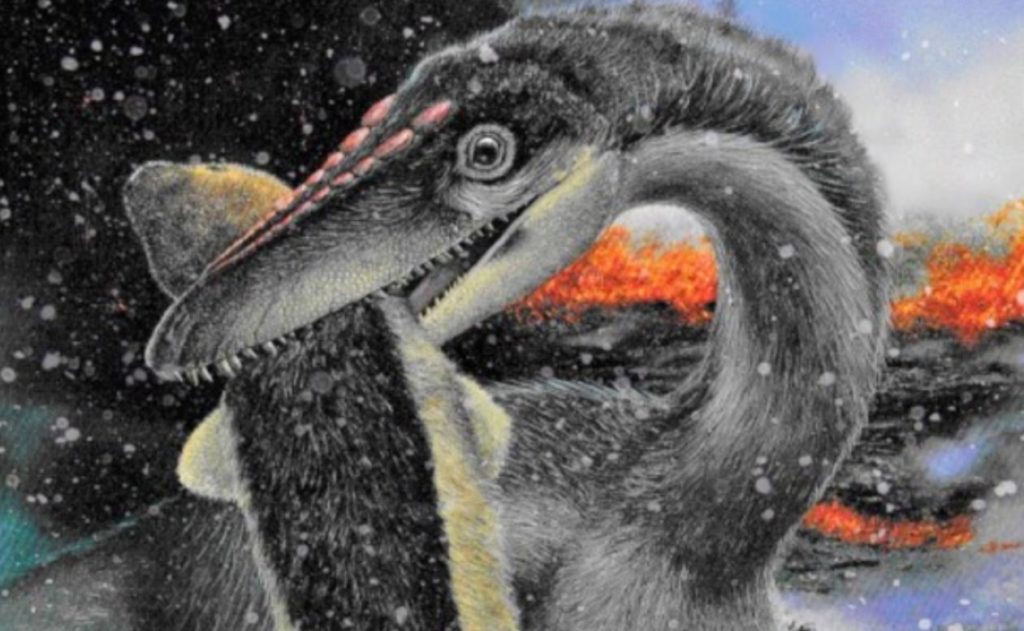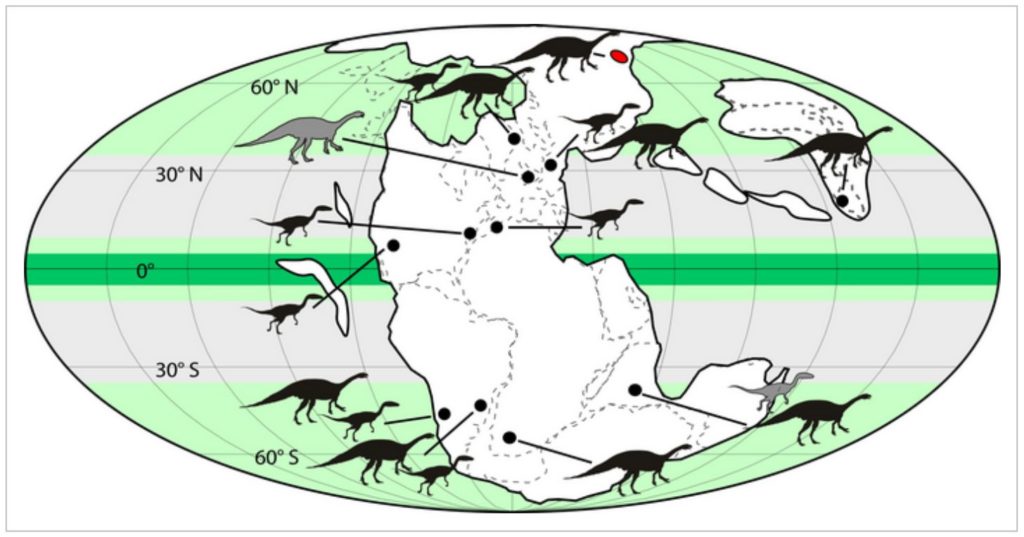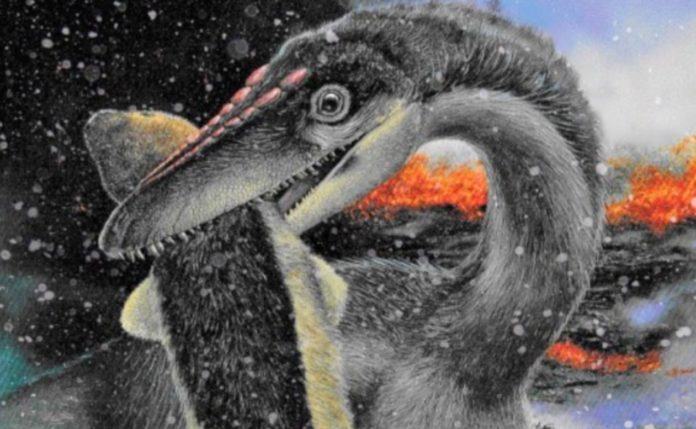The widely accepted hypothesis of how the dinosaurs perished 66 million years ago involves a violent impact between Earth and a meteorite, followed by a global winter during which the atmosphere was choked by dust and debris.
But there was an earlier extinction, considerably more enigmatic and less discussed: the one 202 million years ago, which wiped out the giant reptiles that had previously governed the globe, paving the way for dinosaurs to take over.
What caused the Triassic-Jurassic Extinction, and why did dinosaurs prosper while other animals died?
We know that the world was usually hot and humid during the Triassic Period, which came before the mass extinction, and the Jurassic Period, which came after it and started the age of dinosaurs.
A recent study, however, challenges the notion that dinosaurs enjoyed the heat. It offers the first concrete proof that Triassic dinosaur species, at the time a small group confined mostly to the polar areas, often experienced freezing temperatures there. The telltale signs: dinosaur tracks and unusual rock shards that could only have been deposited by ice.

According to the study’s authors, cold snaps that were already occurring at the poles moved to lower latitudes during the extinction, eradicating the coldblooded reptiles. Dinosaurs, who were already well-adapted, escaped the evolutionary bottleneck and expanded out. The remainder belongs to the past.
The study’s lead author and a geologist at Columbia University’s Lamont-Doherty Earth Observatory, Paul Olsen, said that dinosaurs were present during the Triassic period but were never noticed.
“The key to their eventual dominance was very simple. They were fundamentally cold-adapted animals. When it got cold everywhere, they were ready, and other animals weren’t.”
The study, which is based on current excavations in northwest China’s Junggar Basin’s isolated desert, was just released in the journal Science Advances.
Dinosaurs are considered to have initially appeared some 231 million years ago in temperate southern latitudes, when most of the planet’s surface was linked together in one enormous continent called Pangaea. By around 214 million years ago, they had reached the far north.

CREDIT: Olsen et al., Science Advances, 2022
The more extensive tropical and subtropical regions between were dominated by reptiles, including crocodile relatives and other terrifying monsters, until the great extinction about 202 million years ago.
Temperatures must have been quite high because atmospheric carbon dioxide concentrations during the Triassic and for the majority of the Jurassic ranged at or over 2000 parts per million, which is five times today’s levels.
Polar ice caps are not present today, and excavations have revealed that polar regions once supported deciduous trees. Even with all much CO2, the high latitudes might have been chilly at times since they would have had little sunlight for a large portion of the year and temperatures would have dropped at least periodically. However, nobody has yet shown any concrete proof that they actually did freeze.
At the end of the Triassic, more than three-quarters of all land and sea species died out in a geologically short amount of time, maybe a million years. This included shelled animals, corals, and all large reptiles.
Some burrowing species, such turtles, as well as a few early mammals, survived. Although it is unknown exactly what occurred, many experts believe that it was caused by a succession of enormous volcanic eruptions that may have lasted for hundreds of years at a time.
Around this period, Pangaea began to fragment, creating the Atlantic Ocean and dividing the modern-day Americas from Europe, Africa, and Asia. The eruptions would have, among other things, caused atmospheric carbon dioxide to soar above its already high levels, spiking temperatures on land and making ocean waters too acidic for many organisms to thrive.
A third element is mentioned by the current study’s authors: The strongest phases of the eruptions would have released sulfur aerosols that reflected so much sunlight that they repeatedly generated worldwide volcanic winters that outweighed high greenhouse gas concentrations.
Even the tropics might have experienced prolonged freezing conditions during these winters, which could have lasted a decade or longer. According to the experts, this killed uninsulated reptiles while allowing cold-adapted, insulated dinosaurs to survive.
The evidence presented by the researchers consists of formations of fine-grained sandstone and siltstone that were left by sediments in shallow ancient lake bottoms in the Junggar Basin. The sediments began to accumulate 206 million years ago, during the late Triassic period, and continued to do so even after the mass extinction.
The basin was located at roughly 71 degrees north, high above the Arctic Circle, at that time, before landmasses began to reorganize themselves. Dinosaurs were present along shorelines, as evidenced by the authors’ and others’ discovery of dinosaur footprints. The researchers discovered a lot of pebbles up to 1.5 centimeters in diameter among the typically fine sediments in the lakes itself.
The pebbles had no business being there because they were far from any visible beach. They were ice-rafted debris (IRD), and that was the only possible explanation for their existence.
In a nutshell, IRD is produced when ice forms against a coastal landmass and absorbs pieces of subsurface rock. The ice eventually breaks free and flows into the nearby water body. The rocks fall to the bottom and mix with the typical fine sediments as it melts.
In the oceans, where it is carried by glacial icebergs, ancient IRD has been extensively investigated by geologists, but lake bed research has been sparse; the Junggar Basin discovery fills this gap.
According to the scientists, the pebbles were probably gathered during the winter when lake waters along pebbly shorelines froze. When the weather warmed up again, chunks of ice drifted away, carrying samples of the pebbles with them, and subsequently dropped them.
This demonstrates that these regions saw regular freezing, and the dinosaurs survived unharmed, according to research co-author and geologist Dennis Kent of Lamont-Doherty.
How did they manage it? Since the 1990s, there has been mounting proof that many, if not all, non-avian dinosaurs, including tyrannosaurs, had early feathers.
Some coverings may have served as mating displays if not for flying, but the researchers claim that insulation was their primary function. There is strong evidence that many dinosaurs had warm-blooded, high-metabolism systems, in contrast to the cold-blooded reptiles. In cold climates, dinosaurs would have benefited from both characteristics.
“Severe wintery episodes during volcanic eruptions may have brought freezing temperatures to the tropics, which is where many of the extinctions of big, naked, unfeathered vertebrates seem to have occurred,” according to Kent.
“Whereas our fine feathered friends acclimated to colder temperatures in higher latitudes did OK.”
Although the findings contradict popular notions of dinosaurs, some well-known experts claim to be persuaded. Professor of paleontology and evolution at the University of Edinburgh Stephen Brusatte remarked, “There is a stereotype that dinosaurs always lived in lush tropical jungles, but this new research shows that the higher latitudes would have been freezing and even covered in ice during parts of the year. Dinosaurs living at high latitudes just so happened to already have winter coats [while] many of their Triassic competitors died out.”
Early dinosaur expert and curator of paleontology at the Natural History Museum of Utah, Randall Irmis, fully agrees.
“This is the first detailed evidence from the high paleolatitudes, the first evidence for the last 10 million years of the Triassic Period, and the first evidence of truly icy conditions,” he added.
“People are used to thinking of this as being a time when the entire globe was hot and humid, but that just wasn’t the case.”
More researchers should hunt for fossils in once frigid regions like the Junggar Basin, according to Olsen, in order to better comprehend this time period.
“The fossil record is very bad, and no one is prospecting,” he added. “These rocks are gray and black, and it is much harder to prospect [for fossils] in these strata. Most paleontologists are attracted to the late Jurassic, where it’s known there are many big skeletons to be had. The paleo-Arctic is basically ignored.”
Image Credit: Painting by Larry Felder
You were reading: Triassic-Jurassic Extinction Did Dinosaurs a Huge Favor, New Research Finds
